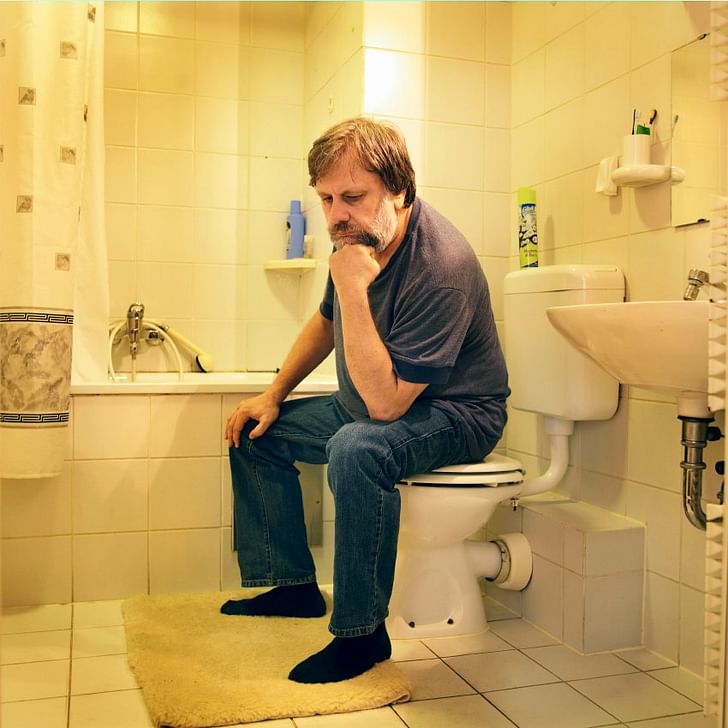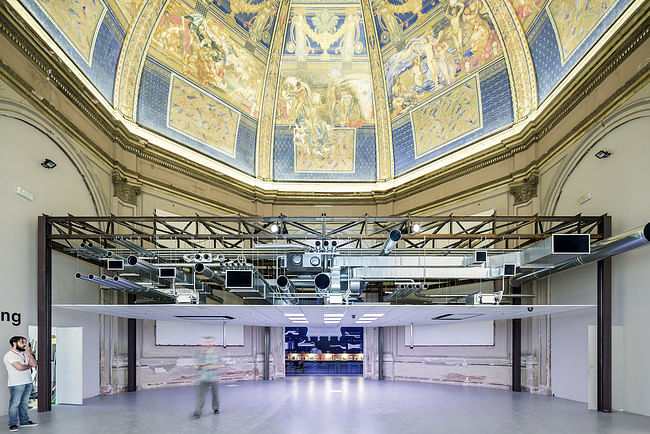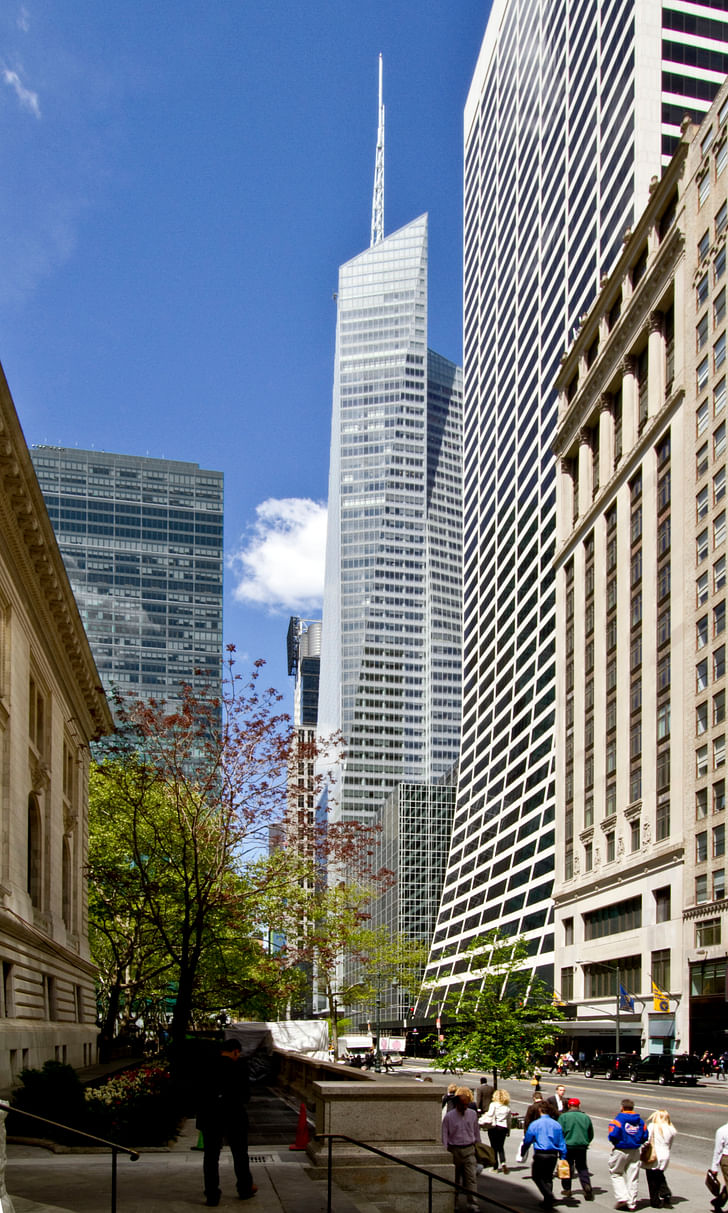

In a recent episode of the Comedy Central show Broad City, protagonists Ilana and Abbi find themselves the inadvertent hosts of a hurricane party. Since the devastation of Hurricane Sandy, such impromptu events – a tradition in the American South in which people who cannot (or will not) evacuate gather together to drink and weather the storm – are increasingly appearing in television shows, revealing the degree to which global warming has infiltrated popular media. In this particular instance, Abbi finds out that the storm has shut off the plumbing at the exact moment that her neighbor-slash-crush arrives, and right after she’s defecated.
A hilarious misadventure typical of the show ensues with Ilana, her best friend, declaring herself a valiant “doo-doo ninja” and promising to take care of it. But with nowhere for the excrement to go, Ilana must literally strap it to her body before cartwheeling off to the trash chute down the hall. In the moment of the disaster, the mechanics of a house suddenly stop working and we have to face up to our own excess – or to put it bluntly, our shit.
These kind of events force us to be aware of the hidden machinery that makes everyday life habitable. During an event like a hurricane, the mechanisms of a building stop working and suddenly become known, like a tool that is only recognized as an actual object when it’s broken and no longer useful. As long as everything works, equipment remains in the background. But there is nothing quite so horrible, that so effectively removes the “home” from the house, as when a septic tank overflows or a pipe breaks and the excrement of the family oozes back out of the holes, refusing to be forgotten. Suddenly, the bathroom, and by extension the whole house, as well as what it symbolically represents, are turned inside out.

In a lecture entitled "Architecture and Aesthetics", originally delivered at Arquitectura y Socieda in 2010, the Slovenian philosopher Slavoj Zizek asserts that for him, architecture is “the exemplary case of how ideology is at work precisely where you don’t think you will find it.” In a humorous social commentary, he distinguishes between toilets in Germany, France and England as evidence of how the most utilitarian of objects are often the most expressive of (in this case, nationalistic) underlying ideologies. He asserts, “There is always an excess, a third space which gets lost in the division of inside and outside. In human dwellings, there is an intermediate space that is disallowed. We all know it exists but we do not really accept its existence. It remains ignored and mostly unsayable.” This space is significantly dedicated to excrement and waste disposal, but it is also the space of air conditioning, electric wiring, fiber optic cables – the behind of architecture, covered by curtains and walls and ceilings as well as willful ignorance. For Zizek, it is no mistake that in popular narratives, these are the spaces for ghosts, monsters, insects and vermin. Repressed, ignored, and banished, these spaces return (often at the worst times) to haunt architecture, demanding recognition.

The attempt to excavate this behind space of architecture by Rem Koolhaas and his curators for the most recent Venice Biennale has been well-noted. Beneath the beautiful painted rotunda of the Arsenale, a chunk of a ceiling space from a typical office building – with its air conditioning ducts, wiring, and drop ceiling – was erected. Another room housed an exhibit tracing the development of toilet design. In the accompanying catalogue, toilets are described as “the fundamental zone of interaction – on the most intimate level – between humans and architecture.” In what could be described as a typical Koolhaasian gesture, rather than banishing bathrooms, the exhibition elevates them as “the architectural space in which bodies are replenished, inspected, and cultivated, and where one is left alone for private reflection - to develop and affirm identity.” In a way, the exhibit illustrates a reading of the development of architecture since modernity as the steady enlargement of this interstitial zone, both spatially and in its importance for architectonics in general.
Timothy Morton, an increasingly important figure in the emergent philosophical school of Object-Oriented Ontology (OOO) and general ecological thinking (among many other disciplines), deconstructs architecture’s foundational disregard of our excess and its removal, reflected particularly in a toilet and the magical “away” suggested in its U-bend. Morton, like Zizek, scrutinizes the banished third spaces of architecture that hide the rationally obvious yet phenomenologically startling truth: that there is, in fact, no metaphysical “beyond” to put our waste.
There is, in fact, no metaphysical 'beyond' to put our waste.
This notion of “away” is, for Morton, the fundamental premise upon which architecture relies. He sees air conditioning units not for the comfort they provide, but as managers of dirty air, and toilets not as banishing our excrement but as dumping it elsewhere. After all, air conditioners don’t filter dirty air; they produce it, consuming massive amounts of energy created, most likely, by polluting fossil fuels. And a toilet simply flushes the water into the ocean that you swim in on your vacation or into a septic tank, only for it to bubble back to the surface, disturbingly. This banishing, this managing of flows, has a name: sustainability.
In his recent book Hyperobjects: Philosophy and Ecology After the End of the World, Morton asks the pivotal question: what does sustainability sustain? (111) Sustainability refers to a loose set of practices and theories that emerged in reaction to global warming, and has since become a sort of “buzzword,” lacking agreed upon guidelines for its use. While guised as a method to sustain “nature” it is actually concerned with sustaining existing economic conditions. This is to say, sustainable capitalism, or the attempt to regulate systems of production to reduce environmental degradation, is still oriented around converting raw material into value despite the fact that this is an fundamentally ecologically destructive endeavor. In purview of Morton’s thought, we can understand sustainability as the preservation of the status quo, albeit with tacit concessions. Sustainable building still feeds the demand to create new terrains for the expenditure of surplus capital. It does this by more efficiently managing energy usage, both in construction and in the building maintenance.

When we take our dirt, our polluted water, our shit somewhere else, that place is still the planet we inhabit.
A “green” building “offsets” its “carbon footprint.” But that is all: it still releases carbon into the atmosphere, bringing the parts per million of atmospheric CO2 ever higher, steadily closer to untenable levels. For example, the Bank of America Tower in New York was heralded as the largest “green” building ever constructed at the time of its opening in 2010 and was heralded as a “model for fighting climate change”. However, since then, it has been revealed to consume more energy and produce more greenhouse gases than any other office building of its size in the city. And when we take our dirt, our polluted water, our shit somewhere else, that place is still the planet we inhabit. This inevitability is well-illustrated by the so-called Great Pacific garbage patch, the massive “island” of trash and waste floating in oceans. Or, perhaps even more frightening, the radioactive waste produced in nuclear facilities that power significant chunks of many major cities has a half-life of around 100,000 years. Quite literally, there is nowhere for this waste to go besides beneath the ground (which is an unpopular prospect to people who live around there, as the controversy around Yucca Mountain has shown). Similarly, used electronics – or e-waste – cannot be “removed” through conversion processes, like fecal matter can be turned into fertilizer. Instead, it usually ends up in dumps where toxic chemicals can leach into the soil and groundwaters. More often than not, it is specifically to the homes of the poorest and least politically enfranchised populations that this waste goes.

Morton contends that sustainable architecture is not the ecological architecture that we must have. He looks at Dusty Relief, a 2002 design for a building by R&Sie that attracts dust to itself rather than funneling it elsewhere. Intended for the dust-filled city of Bangkok, this project seeks to undo the distinction between human practices and their context, as well as utilizing the dust to form a “sun-shield” that could passively cool and heat the structure. Rather than the antiseptically clean, glowing architectural renderings we have become used to, this project suggests a sort of architectural realism. But such a building, if materialized, would still fundamentally makes use of the metaphysical “away” that is implicit in construction. That is to say, construction is impossible without the demolishing of that which was before it; the harvesting of wood, the mining of stone, the burning of coal.
Under the weight of the ecological crisis, the world has been flattened.
On the other hand, a non-sustainable ecological architecture exists already. In refugee enclaves like Zaatari or Gaza, there is no pretense of an away. The residents intimately know that there is no endless supply of fresh water that can both satiate their thirst and wash away their waste. In disaster situations like this, the privilege of disassociating the body from that which it produces does not exist. Like Abbi’s literal “doo-doo ninja”, the excess becomes inseparable from the body. Under the weight of the ecological crisis, the world has been flattened. There is no exit.
Writer and fake architect, among other feints. Principal at Adjustments Agency. Co-founder of Encyclopedia Inc. Get in touch: nicholas@archinect.com
3 Comments
You present this as if there has been no research or progress made in architectural or urban environments that are closed-loop systems, or "cradle-to-cradle" to use buzzwords.
Maybe a follow-up post?
I am always baffled by big houses that are marketed with +5.5 bathrooms (very common in wealthy neighborhoods) and so on. And of course these host extremely hi end living styles. It is kind of funny to think all these people do all day is shit and shit and shit everywhere in the house.
I am a proponent of "infrastructureless architecture" which you can interpret anyway you can.
Studied this some. It is getting so easy to be off-grid, the problem is that it’s still easier/cheaper to hook-up and until the day comes when you can’t hook-up, they won’t let you hook-up or its too expensive to hook-up - the shits going to keep flowing downhill.
Block this user
Are you sure you want to block this user and hide all related comments throughout the site?
Archinect
This is your first comment on Archinect. Your comment will be visible once approved.